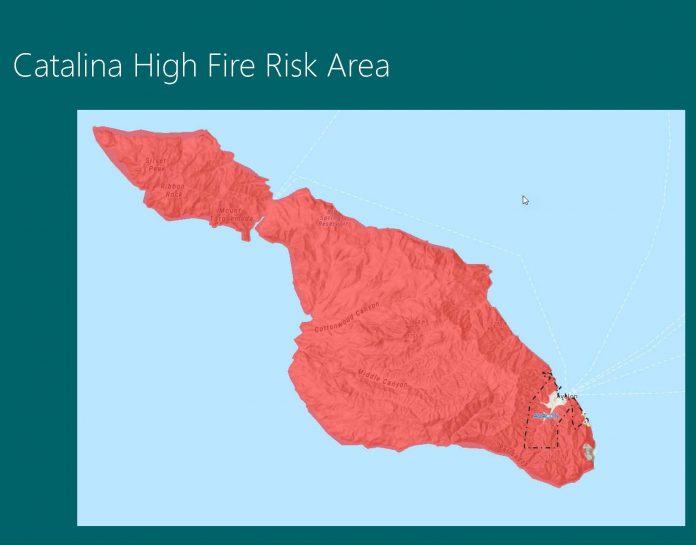
SCE representatives explain new tools for preventing wildfires
Summer is gone and the weather will soon be cooling down. However, in recent years that no longer means California is out of its wildfire threat season. The months of August through November were once considered potential wildfire months.
According to Southern California Edison, which made a wildfire mitigation presentation to the Avalon City Council on Tuesday, those months are no longer the only months of concern.
“We’re now in a 12-month fire season,” Bob Stiens, SCE senior government relations adviser told the council.
Stiens was part of a group of SCE advisors who attended the meeting to update the council on SCE’s efforts to prepare for and prevent major wildfires throughout the state. As for Catalina Island, aside from the city of Avalon and some small patches on the south end of the island, Catalina is a high-risk area.
“All of the island of Catalina is in what we call a tier 3, which is the highest fire risk area,” Stiens said.
In recent years, SCE has ramped up its efforts to mitigate the chances of wildfires starting due to power line sources. Stiens outlined those efforts for the council. One of the major efforts has come in limiting potential heat sources that can spark a fire.
Power lines are being replace with better insulated lines that will resist sparking a fire in the event of a downed line, or being contacted by a tree branch or fallen tree. They are also installing more cameras in remote, high risk areas so that they can better monitor potential problems that might lead to fires.
SCE has also begun installing weather stations that monitor winds, heat, humidity levels and other environmental conditions that could create higher fire risks. While SCE has not installed any of the weather stations on Catalina as of yet, they have begun scouting locations for them.
“We’ve got 3 or 4 locations in mind but we want to get some confirmation on that,” Stiens said.
Other issues that Stiens addressed are measures such as modernized automatic shutoff devices to shut down power lines in instances of problems, as well as removing trees and plants from around power line areas.
“Vegetation management is a big project for us,” Stien said.
The installation of more detection equipment, such as the cameras and weather stations also allow for SCE to implement manual shutdowns (Public Safety Power Shutoff) if fire potential spikes for any reason. Stiens noted that those power shutdowns are never taken lightly and that SCE does it’s best to keep people informed before they make the decision to shut down.
He urged residents to go online to sce.com/psps to register themselves and provide contact information so that they can be notified in the event of an upcoming shut down. He also encouraged everyone to have an emergency preparedness plan for planned and unplanned outages.
There were no questions on the fire mitigation presentation, which lasted nearly 30 minutes, from the council.
“I think that was very thorough,” Mayor Anni Marshall said.
Council member Cinde MacGugan-Cassidy did ask if SCE could return and give an update on the water in terms of grants and when there might be some construction upgrades for the island’s water system. Adeline Yoong, SCE Govt. Relations adviser, said that there has not been any new information since the last time they updated the council but said they would be back when there was something new
“We will come before whenever there is anything we need to share with the council with regards to water,” Yoong said.










